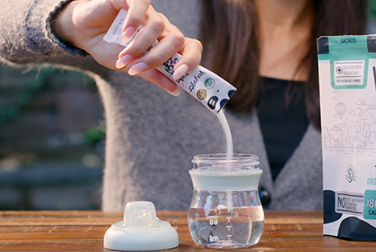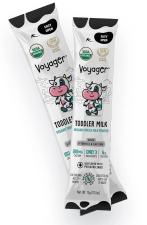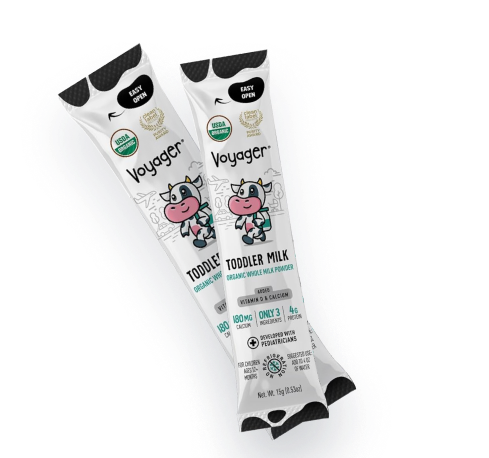
Smooth Transition from Formula or Breast Milk to Whole Milk
Once our little ones reach 12 months, the American Academy of Pediatrics (AAP) recommends offering pasteurized whole cow’s milk (3.25% fat) as a beverage—about 16–24 ounces per day—while solid foods become their primary source of nutrition.
Transitioning your little one from formula or breast milk to whole milk can feel like a big step. With a clear plan and gentle approach, you can make it a smooth and positive experience for both of you. This guide will walk you through the why, when, and how of the transition, plus tips for handling any bumps along the way.
With Voyager Milk, you can keep a pouch in the cabinet and always have fresh, organic milk available as our milk is shelf-stable for up to 2 years!
Why Switch to Whole Milk?
Moving to whole milk has key benefits for your toddler’s growth and development:
- Whole milk is rich in healthy fats that support brain and nervous system development
- It provides calcium and vitamin D to build strong bones and teeth
- It’s an easy, cost-effective source of calories and nutrients as solids become their main diet
Understanding these benefits helps you stay motivated and confident throughout the transition.
When to Start the Transition
Most pediatricians recommend beginning the switch around 12 months of age. At this point:
- Your toddler’s digestive system is more mature
- Solid foods are the primary source of nutrition
- You can reduce dependence on formula or breast milk
Always check with your child’s healthcare provider before making major feeding changes.
Preparing for the Change
A little planning makes a big difference:
- Gather supplies
- Choose whole cow’s milk, like Voyager Milk or a fortified alternative if needed
- Stock sippy cups or toddler-friendly open cups
- Talk it up
- Let your child see you enjoying milk
- Read books or sing songs about “big kid” drinks
- Make Voyager Milk together – tear, pour, and do a little shake!
- Schedule around meals
- Offer milk with breakfast and lunch, then drop nighttime feeding last
- Keep mealtimes consistent to maintain appetite for solids
Step-by-Step Transition Plan
Use this 2-week schedule as a flexible guideline:
Week 1
- Replace one daytime bottle or breastfeeding session with whole milk (great to mix in a little Voyager milk at a time)
- Keep other feeds as usual
- Note any signs of discomfort or full tummy
Week 2
- Replace a second daytime feed with whole milk
- Continue solids at main meals
- Offer water between milk and meals
Week 3
- Swap the final daytime feed
- Breastfeed or formula only at bedtime if desired
- Observe appetite and mood
Week 4
- Replace bedtime feed if ready
- Maintain routine: milk with meals only
- Praise your toddler for being a “big kid”
Adjust pacing if your child shows resistance or tummy upset. Stretch each step by a few days if needed. (Disclaimer, we are not doctors, this is what worked best for us! Check with your pediatrician if you have any concerns).
Tips for Handling Fussiness
Toddlers may resist change. Try these strategies:
- Mix old and new
Start with a 75/25 ratio of formula/breast milk to whole milk, then gradually shift to 50/50. - Add a fun twist
Use colorful cups or straws to make milk more exciting. - Stay calm and consistent
Offer milk at regular times, even if they refuse. Don’t force a full cup—small sips count. - Distract with play
Offer a toy or story while they sip to build positive associations.
Frequently Asked Questions
Q: What if my toddler refuses whole milk?
A: Try mixing with formula or adding a drop of vanilla extract. Offer praise for any sips and revisit later.
Q: Can I switch to plant-based milk?
A: Only use fortified soy milk as a true dairy alternative. Other plant milks often lack enough protein and fat for toddlers.
Q: How much whole milk is enough?
A: Aim for 16–24 ounces per day. Too much milk can fill them up and reduce solid food intake.
Next Steps
- Talk with your pediatrician to confirm timing.
- Shop for whole milk (order Voyager conveniently online!) and toddler cups this week.
- Follow the two-week plan, adjusting as needed for your child’s pace.
- Celebrate each small step—your toddler will soon enjoy this “big kid” drink!
With patience and consistency, your toddler’s move to whole milk will be a healthy milestone. Cheers to growing up!

